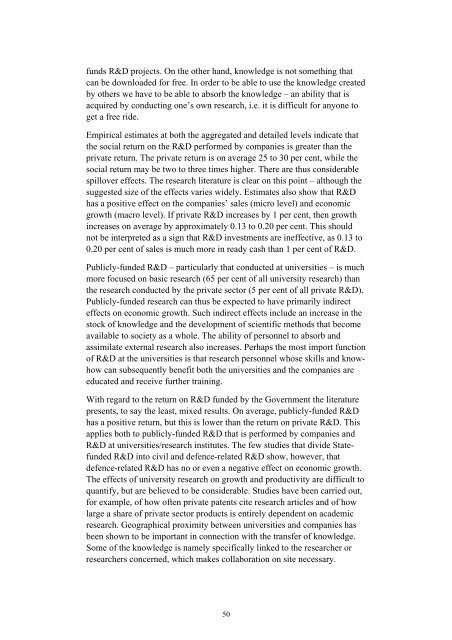Growth through Research and Development - what does ... - Vinnova
Growth through Research and Development - what does ... - Vinnova
Growth through Research and Development - what does ... - Vinnova
You also want an ePaper? Increase the reach of your titles
YUMPU automatically turns print PDFs into web optimized ePapers that Google loves.
funds R&D projects. On the other h<strong>and</strong>, knowledge is not something thatcan be downloaded for free. In order to be able to use the knowledge createdby others we have to be able to absorb the knowledge – an ability that isacquired by conducting one’s own research, i.e. it is difficult for anyone toget a free ride.Empirical estimates at both the aggregated <strong>and</strong> detailed levels indicate thatthe social return on the R&D performed by companies is greater than theprivate return. The private return is on average 25 to 30 per cent, while thesocial return may be two to three times higher. There are thus considerablespillover effects. The research literature is clear on this point – although thesuggested size of the effects varies widely. Estimates also show that R&Dhas a positive effect on the companies’ sales (micro level) <strong>and</strong> economicgrowth (macro level). If private R&D increases by 1 per cent, then growthincreases on average by approximately 0.13 to 0.20 per cent. This shouldnot be interpreted as a sign that R&D investments are ineffective, as 0.13 to0.20 per cent of sales is much more in ready cash than 1 per cent of R&D.Publicly-funded R&D – particularly that conducted at universities – is muchmore focused on basic research (65 per cent of all university research) thanthe research conducted by the private sector (5 per cent of all private R&D).Publicly-funded research can thus be expected to have primarily indirecteffects on economic growth. Such indirect effects include an increase in thestock of knowledge <strong>and</strong> the development of scientific methods that becomeavailable to society as a whole. The ability of personnel to absorb <strong>and</strong>assimilate external research also increases. Perhaps the most import functionof R&D at the universities is that research personnel whose skills <strong>and</strong> knowhowcan subsequently benefit both the universities <strong>and</strong> the companies areeducated <strong>and</strong> receive further training.With regard to the return on R&D funded by the Government the literaturepresents, to say the least, mixed results. On average, publicly-funded R&Dhas a positive return, but this is lower than the return on private R&D. Thisapplies both to publicly-funded R&D that is performed by companies <strong>and</strong>R&D at universities/research institutes. The few studies that divide StatefundedR&D into civil <strong>and</strong> defence-related R&D show, however, thatdefence-related R&D has no or even a negative effect on economic growth.The effects of university research on growth <strong>and</strong> productivity are difficult toquantify, but are believed to be considerable. Studies have been carried out,for example, of how often private patents cite research articles <strong>and</strong> of howlarge a share of private sector products is entirely dependent on academicresearch. Geographical proximity between universities <strong>and</strong> companies hasbeen shown to be important in connection with the transfer of knowledge.Some of the knowledge is namely specifically linked to the researcher orresearchers concerned, which makes collaboration on site necessary.50
















